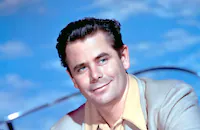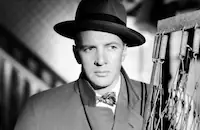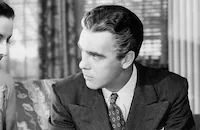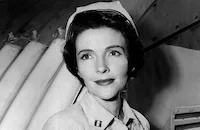The Doctor and the Girl

Brief Synopsis
Cast & Crew
Curtis Bernhardt
Glenn Ford
Charles Coburn
Gloria De Haven
Janet Leigh
Bruce Bennett
Film Details
Technical Specs

Synopsis
Having just completed his medical schooling at Harvard, Michael Corday arrives at the Department of Neurology at New York City's Bellevue Hospital to begin his internship. Michael's snobbish father, John Corday, is also a physician, as is his sister Mariette's fiancé, George Esmond. When Michael accuses George of being an opportunist and wanting to marry Mariette only to be associated with a prominent family of doctors, George denies the accusation. At the hospital, Michael's emergency room internship gets off to a bad start when he is accused by another physician, Dr. Granville, of being brusque with his patients. As rumors of Michael's poor bedside manners spread throughout the department, Michael begins to take notice of the criticism and decides to change his ways.
When one of his patients, a penniless candy store employee named Evelyn Heldon, complains about being placed in a crowded room for the "moribund," Michael has her transferred to another room. Michael eventually befriends Evelyn and sees to it that her complicated lung abscess operation is performed by Dr. Francis I. Garard, the best surgeon in the department. Meanwhile, Michael's young sister Fabienne decides to defy her father's wishes and leaves home to live on her own in Greenwich Village. The Corday family is thrown into further turmoil when Michael falls in love with Evelyn, and Michael's father asks Frank to pay Evelyn to leave him. Michael is devastated when he learns of the pay-off, and wanders the streets in search of her.
After seeking the advice of Dr. Alfred Norton, who suggests that he follow his heart, Michael finds Evelyn working hard at her taffy machine. Noticing that she does not have enough money to buy food, Michael decides to postpone his marriage plans until he can help her regain her strength. Back at the Corday home, Michael's father falls ill, and because Fabienne refuses to return home to care for him, Mariette is forced to call off her wedding to do so. With Evelyn's help, Michael opens a private practice on Third Avenue, in a poorer neighborhood, but he eventually starts to long for an apprenticeship under a skilled doctor. Late one night, Fabienne, whose boyfriend has deserted her, collapses at Michael's doorstep. Hemorrhaging from a botched abortion, Fabienne is rushed to a doctor, but dies in surgery. After caring for a young boy who has injured his hand, Michael decides to continue practicing medicine on Third Avenue, and he and Evelyn look forward to running a successful practice together.

Director

Curtis Bernhardt
Cast

Glenn Ford

Charles Coburn

Gloria De Haven

Janet Leigh

Bruce Bennett

Warner Anderson
Basil Ruysdael

Nancy Reagan

Arthur Franz
Lisa Golm
Joanne De Bergh
Irving Smith
Ottola Nesmith
June Booth
Lucille Curtis
Lisl Valetti
Cecil Weston
Gail Bonney
Kay Deslys
Hazel Keener
Marion Gray
Frank Mills
Tom Dillon
Larry Thompson
Clark Howatt
Wilson Wood
Edward Emerson
Alex Gerry
Alvin Hammer
Garry Owen

Bernard Gorcey
Ben Weldon
Ben Hall
Paul Kreibich
Sarah Padden
Virginia Mullen
Frank Wilcox
Steve Pendleton
David Bond

Ken Tobey

Angela Clarke
William H. Vedder
Jody Gilbert
Sid Tomack
Edward Rose
Robert Dominguez
Fernando Alvarado
Peter Roman
Mimi Aguglia
Felipe Turich

Harlan Warde
James Lombardo
Renata Vanni
Mario Seletti
Toby Green
Bessie Wade
Mildred Boyd
Joe Dominguez
Carlotta Monti
Jessie Arnold
Esther Michelson
Crew
Preston Ames
Pandro S. Berman
Jack Dawn
Cedric Gibbons
Sydney Guilaroff
Rudolph G. Kopp
Arthur Krams
Robert Planck
Al Raboch
Theodore Reeves
Douglas Shearer
Ferris Webster
Edwin B. Willis

Film Details
Technical Specs

Articles
The Doctor and the Girl
This was one of two movies (along with High Wall, 1947) that Curtis Bernhardt directed for MGM after seven years at Warner Brothers, where he had made such films as Conflict (1945), My Reputation (1946) and Possessed (1947). The German-born director later said, "MGM was like a big, big opera house, where you had to please this star and that prima donna." Ironically, The Doctor and the Girl was a bit more like a Warner Brothers film than a typical MGM concoction; MGM production chief Dore Schary was making a conscious effort to produce grittier movies. Doctor is still a glossy soap opera, but it has more grit than is usual for MGM. One effect of the new push for realism was more MGM movies shot on location, with such disparate titles as Adam's Rib (1949), a comedy, On the Town (1949), a musical, and Side Street (1950), a film noir, following The Doctor and the Girl with prominent Manhattan locations.
The Doctor and the Girl shot all over the city, and Bernhardt later recalled hiding his camera in a special camera car so he could shoot among New Yorkers surreptitiously. He also remembered filming "some scenes on 42nd Street, I think, from the inside of a milk parlor. We shot through the window outside and people couldn't tell we were putting them on film." Other times, the camera unit roped off large areas for filming, including much of Times Square.
Doctor opened in September 1949 to respectable, if not overwhelming, reviews. The New York Times called it "a nice little bedside tearjerker" and praised the cast: "Glenn Ford does a satisfactory job... Janet Leigh is winsome and bewitching." The Times and Variety also sung the praises of supporting player Charles Coburn, who was one of Hollywood's greatest character actors.
Janet Leigh had so much fun making this film it was embarrassing. As she wrote in her memoir, "In one scene, Glenn had to carry me up two flights of stairs; it was supposed to be our wedding night. We were in high spirits, with much ad-libbing and giddiness. Glenn kept whispering, 'I don't think I can make it.' And the more he struggled, the harder we laughed, until finally I passed the threshold of restraint and wet my pants, which only made me laugh harder...I swear I could see a spot on my skirt in the actual film."
The Doctor and the Girl was the first credited, released film for Nancy Davis -- the future Nancy Reagan -- although she had previously filmed a speaking part in Shadow on the Wall, which would be released in 1950.
Producer: Pandro S. Berman
Director: Curtis Bernhardt
Screenplay: Theodore Reeves; Maxence van der Meersch (story "Bodies and Souls")
Cinematography: Robert H. Planck
Art Direction: Preston Ames, Cedric Gibbons
Music: Edward Ward
Film Editing: Ferris Webster
Cast: Glenn Ford (Dr. Michael Corday), Charles Coburn (Dr. John Corday), Gloria DeHaven (Fabienne Corday), Janet Leigh (Evelyn 'Taffy' Heldon), Bruce Bennett (Dr. Alfred Norton), Warner Anderson (Dr. George Esmond), Basil Ruysdael (Dr. Francis I. Garard), Nancy Davis (Mariette Esmond), Arthur Franz (Dr. Harvey L. Kenmore), Lisa Golm (Hetty), Joanne De Bergh (Child's mother).
BW-98m.
by Jeremy Arnold
Sources:
Mary Kiersch (interviewer), Curtis Bernhardt: A Directors Guild of America Oral History
Janet Leigh, There Really Was a Hollywood
William R. Meyer, Warner Brothers Directors

The Doctor and the Girl
Kenneth Tobey (1917-2003)
Born in Oakland, California on March 23, 1917, Tobey originally intended to be a lawyer before a stint with the University of California Little Theater changed his mind. From there, he went straight to New York and spent nearly two years studying acting at the Neighborhood Playhouse, where his classmates included Gregory Peck, Eli Wallach and Tony Randall. Throughout the '40s, Tobey acted on Broadway and in stock before relocating to Hollywood. Once there, Tobey soon found himself playing a tough soldier in films like I Was a Male War Bride and Twelve O' Clock High (both 1949); or a tough police officer in Kiss Tomorrow Goodbye and Three Secrets (both 1950). Such roles were hardly surprising, given Tobey's craggy features, unsmiling countenance and rough voice.
Needless to say, no-nonsense, authority figures would be Tobey's calling for the remainder of his career; yet given the right role, he had the talent to make it memorable: the smart, likeable Captain Hendrey in The Thing From Another World (1951); the gallant Colonel Jack Evans in the "prehistoric dinosaur attacks an urban center" genre chiller The Beast from 20,000 Fathoms (1953, a must-see film for fans of special effects wizard, Ray Harryhausen; and as Bat Masterson, holding his own against Kirk Douglas and Burt Lancaster in Gunfight at the O.K. Corral (1957).
Television would also offer Tobey much work: he had his own action series as chopper pilot Chuck Martin in Whirlybirds (1957-59); and had a recurring role as Assistant District Attorney Alvin in Perry Mason (1957-66). He would also be kept busy with guest appearances in countless westerns (Gunsmoke, Bonanza, The Virginian) and cop shows (The Rockford Files, Barnaby Jones, Ironside) for the next two decades. Most amusingly, the tail end of Tobey's career saw some self-deprecating cameo spots in such contemporary shockers as The Howling (1981); Strange Invaders (1983) and his role reprisal of Captain Hendry in The Attack of the B-Movie Monsters (2002). Tobey is survived by a daughter, two stepchildren, and two grandchildren.
by Michael T. Toole
Kenneth Tobey (1917-2003)
Quotes
Trivia
Notes
The working title of this film was Bodies and Souls. A March 1948 Variety news item noted that M-G-M paid $50,000 for the film rights to Maxence Van der Meersch's novel. According to M-G-M studio publicity materials contained in the AMPAS Library file for the film, much of the picture was filmed on location in New York City. Among the various Manhattan location sites used for film were: Patchin Place in Greenwich Village, Third Avenue, Forty-Second Street, Times Square, Bellevue Hospital and Columbia-Presbyterian Medical Center. According to publicity materials, director Curtis Bernhardt used a camoflaged camera, hidden in a truck, to film location scenes on Forty-Second Street. Bernhardt also used a camera hidden in a fake wall in a coffee shop to film people undetected.

Miscellaneous Notes
Released in United States Fall September 1949
Released in United States Fall September 1949














